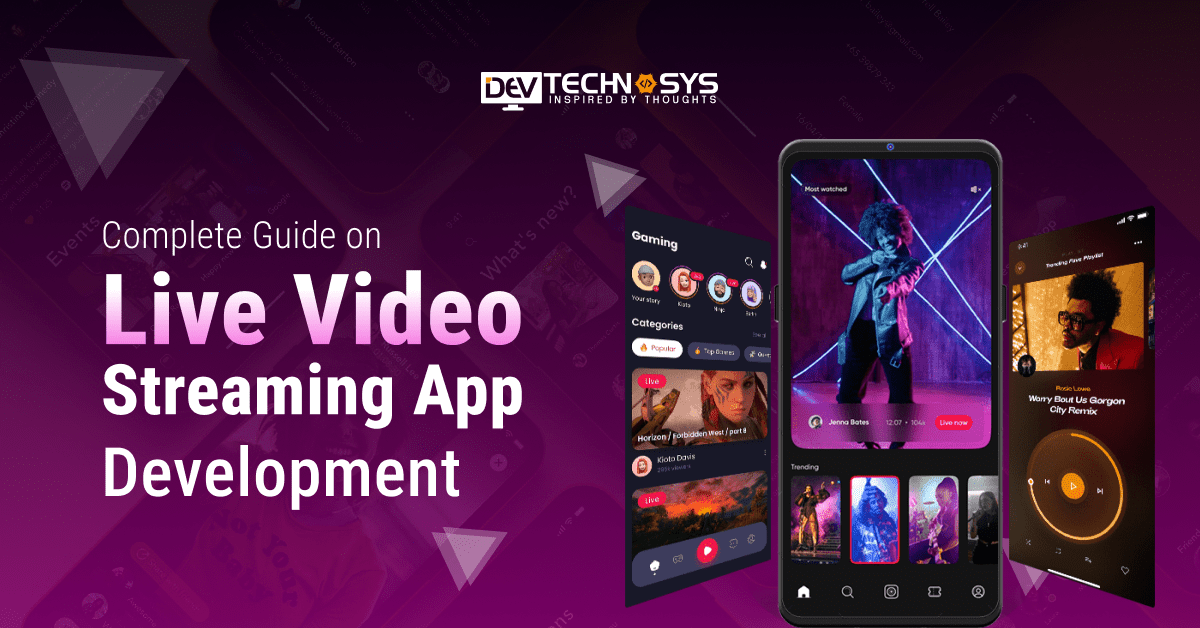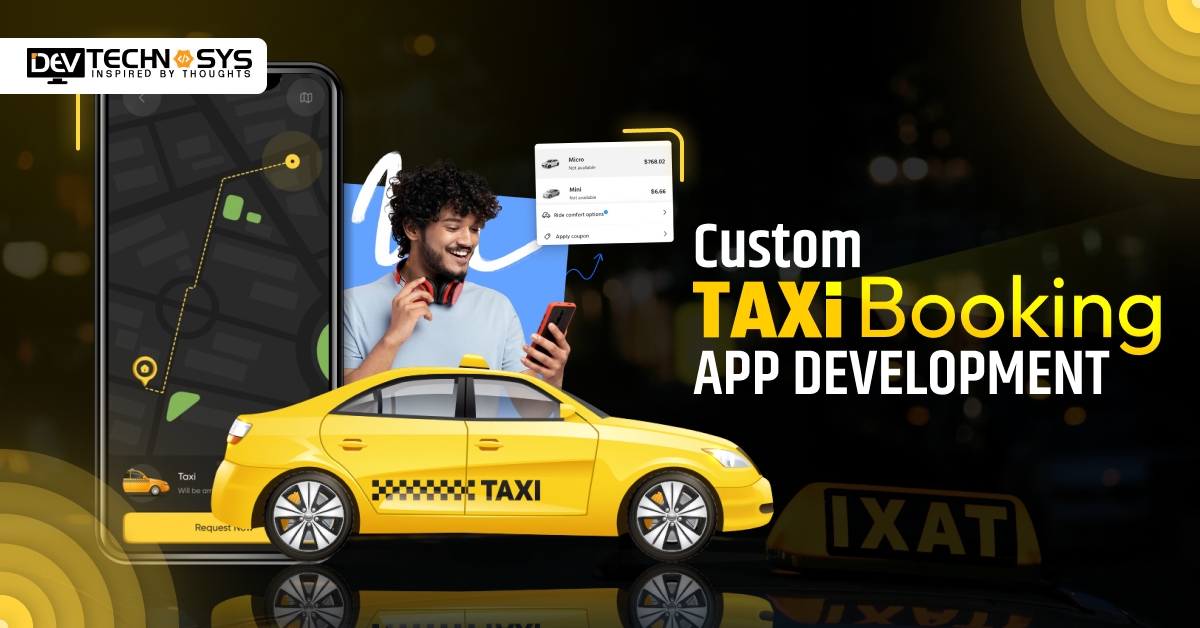There was a time when people used to stand in line to buy movie tickets, and they needed to purchase CDs to watch any movie again. But now we enter this modern world, where many popular live video streaming apps, such as Twitch, Streamlabs, and YouTube Live, enable users to watch live video without downloading to a device.
As per the global survey, the real-time video broadcasting apps were valued at around $119.09 billion in 2025. This is expected to increase to around $155.51 billion by the end of 2029. This useful data depicts that investing in live video streaming app development is the highest profit-making opportunity for entrepreneurs.
Let’s explore how to build a live video streaming app, various premium features that must be integrated, development costs, benefits, and money-making techniques.
What is a Live Video Streaming App?
A live video broadcasting app enables users to share real-time video material with an internet audience. These apps allow users to livestream events, performances, seminars, and personal moments. They usually have features like chat, notifications, and social sharing. Popular examples are YouTube Live, Instagram Live, and Twitch. These platforms are commonly used for entertainment, education, marketing, and social media involvement.
- Real-Time Streaming
- Interactive Chat
- Video Quality Settings
- Recording and Playback
Market Analysis of Global Live Video Streaming Applications
- The global revenue from video streaming (SVoD) is expected to reach US$119.09 billion by 2025.
- Revenue is estimated to expand at a 90% annual rate (CAGR 2025-2029), with a projected market volume of US$155.51 billion by 2029.
- With an anticipated revenue of US$47.89 billion in 2025, the United States will contribute the majority of worldwide revenue.
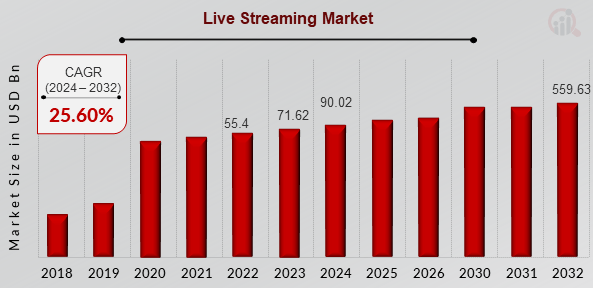
- In the global video streaming (SVoD) industry, the average revenue per user (ARPU) is expected to reach US$78.97 by 2025.
- By 2029, there will likely be 7 billion subscribers globally in the Video Streaming (SVoD) business.
10 Best Live Video Streaming Applications
The most popular custom video streaming apps are listed in this table, covering both specialized streaming services (like Twitch and Vimeo) and social media-based streaming (like YouTube and Facebook).

| Applications | Download Users | Stores Ratings | Apps Launched On | Platform Accessibility |
| YouTube Live | 10B+ | 4.5 | 2005 | Android, iOS, Web |
| Instagram Live | 1B+ | 4.7 | 2010 | Android, iOS, Web |
| Twitch | 100M+ | 4.6 | 2011 | Android, iOS, Web |
| Periscope | 10M+ | 4.0 | 2015 | Android, iOS |
| Zoom | 500M+ | 4.6 | 2011 | Android, iOS, Web |
| Trovo | 1M+ | 4.6 | 2020 | Android, iOS, Web |
| Voxer | 10M+ | 4.5 | 2011 | Android, iOS |
| OBS Studio | 100M+ | 4.7 | 2012 | Windows, macOS, Linux |
| Twitch Studio | 1M+ | 4.5 | 2019 | Windows, macOS |
| YouNow | 10M+ | 4.3 | 2011 | Android, iOS, Web |
Why Businesses Must Invest in Live Video Streaming App Development?
In today’s digital age, live video streaming has evolved into an effective tool for businesses to engage with their audience, promote products, and increase brand awareness. Here are five main reasons why firms should invest in live streaming app development:
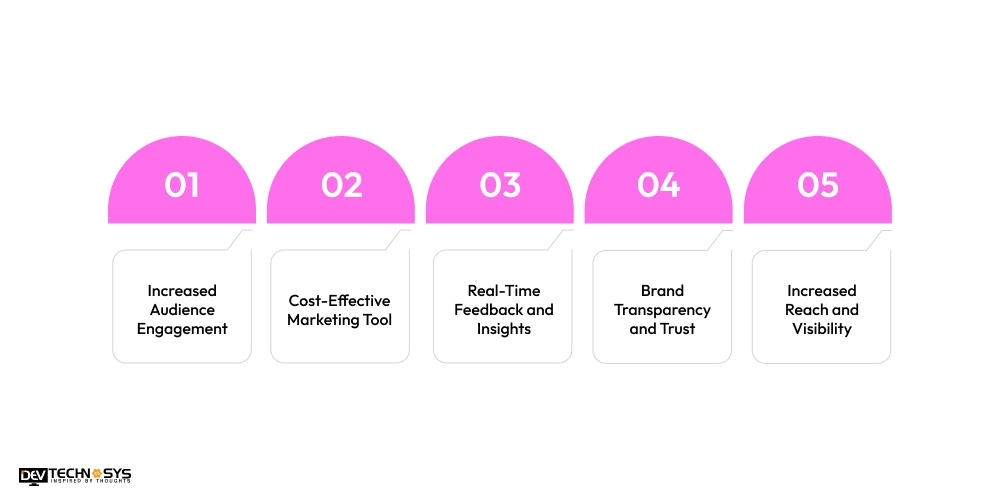
1. Increased Audience Engagement
Live streaming enables businesses to interact with their audience in real-time, building a sense of connection and trust. Unlike traditional media, which is one-way, live streaming offers an interactive platform. Viewers can add comments, ask questions, and share their ideas, making the experience more interactive.
2. Cost-Effective Marketing Tool
Live streaming is a much more cost-effective solution than traditional advertising tactics such as TV advertisements or print ads. With little expenditure, businesses can reach a worldwide audience in real-time. Whether it’s a product launch, seminar, or behind-the-scenes peek, live streaming is a low-cost approach to promoting your business.
3. Real-Time Feedback and Insights
Live streaming app like Shahid allow businesses to obtain quick responses from their audience, which helps them better understand client preferences and perspectives. This real-time data enables firms to quickly change their marketing tactics, optimize product offers, and improve consumer experiences.
4. Brand Transparency and Trust
Real-time video streaming app allows firms to exhibit their authenticity and openness. Live streaming helps to humanize your business by sharing corporate updates, organizing Q&A sessions, and providing product demos. This authenticity fosters trust in your audience, making them more inclined to become devoted consumers.
5. Increased Reach and Visibility
The custom OTT app solutions
7 Basic Steps to Build a Live Video Streaming App
To make a live video streaming app, use a backend like Node.js or Django with WebRTC for real-time video communication. Integrate a media server (like Wowza or Kurento) to handle streaming. For front end, use React or Vue.js with a video player library like Video.js or JWPlayer. Ensure scalability with cloud services (AWS, Firebase).
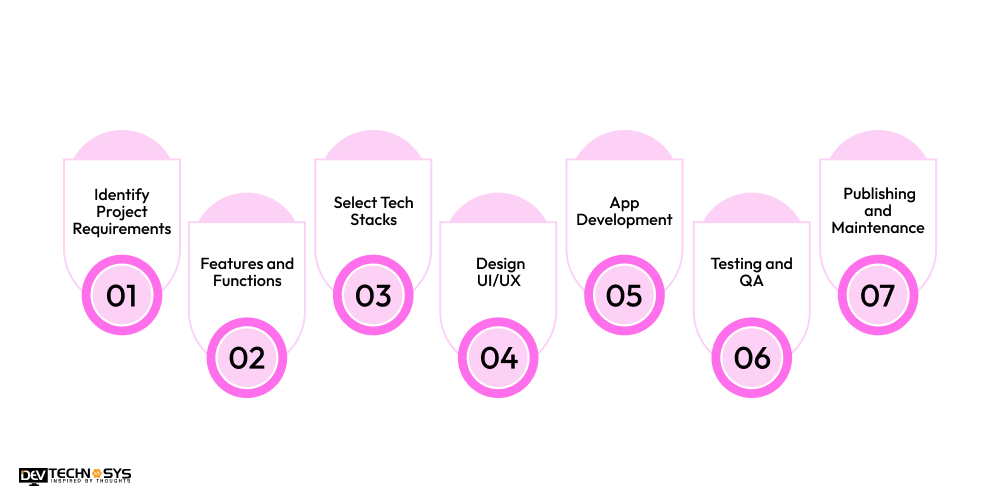
1. Identify Project Requirements
Let’s start the first stage of live broadcasting app development, start by understanding the app’s core purpose, target audience, and key features. Define goals, budget, and timeline, considering whether it’s for entertainment, education, or business. Conduct market research to align with industry trends and user demands.
| What are your app’s basic or core requirements? |
| Clear your app’s future goals. |
| Which live broadcasting apps are more successful and trending in this competitive market? |
2. Features and Functions
Let’s move to the second stage of native video app development, and determine the essential features like live streaming, chat, monetization tools, video quality options, and security. Decide on premium features such as screen sharing, on-demand playback, and multi-platform support. Prioritize ease of use and scalability in the feature list.
| What are your app’s basic or premium features and functions? |
| Observe the existing live video platforms for the best features. |
| Make an organized sheet of features and functions to reduce data redundancy. |
3. Select Tech Stacks
In the third stage of live video streaming app development, choose the right technology stack for front-end, back-end, and video streaming. Opt for reliable frameworks, programming languages, cloud storage, and streaming protocols. Popular options include React, Node.js, AWS, and HLS (HTTP Live Streaming) for smooth performance and scalability.
| Which type of tech stacks are used in your live content streaming app development? |
| Define your scalability requirements. |
| Choose advanced or basic tech stacks. |
4. Design UI/UX
In the fourth stage of cross-platform video app development, design an intuitive, user-friendly interface that provides seamless navigation. Focus on mobile and desktop responsiveness, easy access to key features, and visually appealing layouts. Ensure smooth live-streaming controls, engaging chat options, and easy content discovery for users.
| What are wireframes in UX design? |
| What tools do you use for prototyping? |
| How do you ensure a responsive design? |
5. App Development
Moving the fifth stage of live video app development, begin coding the app based on the finalized design and features. Develop both front-end (user interface) and back-end (servers, databases, streaming services). Implement necessary APIs and integrate live streaming functionality, ensuring smooth video delivery and real-time interaction.
| Do you want to create hybrid or native apps? |
| Choose highly talented mobile app developers. |
| Integrate a high number of features and functions. |
6. Testing and QA
Coming to the sixth stage of custom streaming app development, conduct thorough testing across different devices and platforms to ensure performance, security, and usability. Perform load testing to ensure the app can handle high traffic. Identify bugs and optimize the app for smooth streaming, fast load times, and secure transactions.
| Make sure that all features and functions are working properly |
| Use various testing methods, such as functional and usability testing. |
| Check the app’s security measurements. |
7. Publishing and Maintenance
Once tested, hire a custom web development company in UAE to publish the app on platforms like the App Store or Google Play. Provide ongoing maintenance for bug fixes, security updates, and feature enhancements. Monitor app performance, handle server management, and ensure compatibility with new devices or OS versions.
| Publish your app on selected platforms like Android and iOS. |
| Use the best marketing techniques. |
| Assign the post-maintenance phases to maintain the app’s performance. |
10 Must-Have Premium Features of Live Video Streaming Apps
When creating a live video streaming service, including premium features can dramatically improve the user experience, increase engagement, and create a competitive advantage. Here are live video streaming app features:
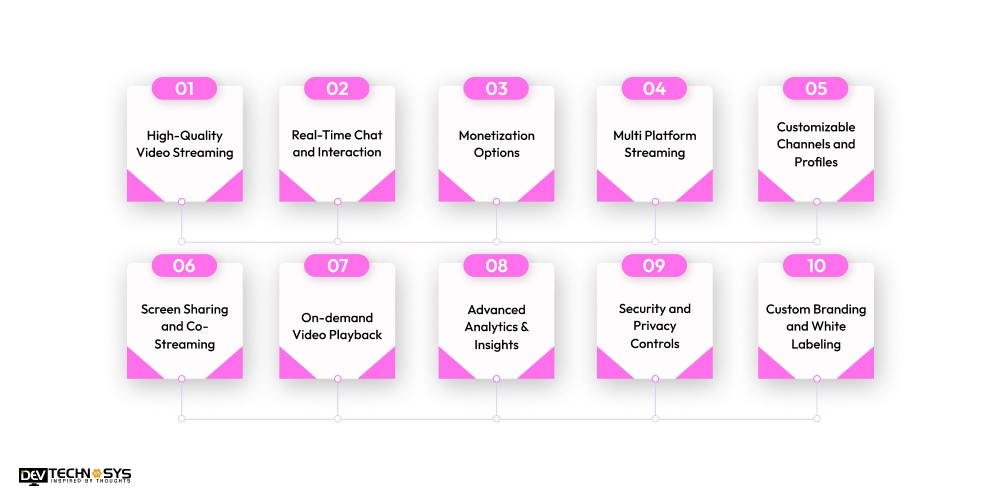
1. High-Quality Video Streaming
Ensure that customers may stream material in HD or 4K resolution while adapting to varying internet speeds for seamless, buffer-free viewing.
2. Real-Time Chat and Interaction
Netflix alternatives in UAE enable live chat tools so that viewers may interact with the streamer, ask questions, and leave comments, resulting in an immersive experience.
3. Monetization Options
Integrate features like tipping, paid subscriptions, virtual gifts, and pay-per-view models to help creators monetize their streams more successfully.
4. Multiplatform Streaming
Allow users to stream on numerous sites at once, such as YouTube, Facebook, and Instagram, to broaden their audience reach.
5. Customizable Channels and Profiles
Users should be able to personalize their profiles, channels, and content to create a more specialized and professional image.
6. Screen Sharing and Co-Streaming
An app like Jio Cinema enables co-streaming and screen-sharing for collaborative content, lessons, and presentations, providing more streaming choices.
7. On-demand Video Playback
Live stream app for Android/iOS allow users to access previously streamed video-on-demand, giving audiences the freedom to interact with information at their leisure.
8. Advanced Analytics & Insights
Live video streaming solutions provide streamers with precise information on their audience, including as demographics, engagement rates, and real-time performance indicators.
9. Security and Privacy Controls
To safeguard both streamers and viewers, use comprehensive security features such as end-to-end encryption, secure payment processing, and privacy settings.
10. Custom Branding and White Labeling
Video streaming mobile apps allow businesses to customize the app with their branding, logo, and colors to ensure a consistent and professional appearance across their platform.
The Cost to Build a Live Video Streaming App
The cost to develop a video streaming app typically ranges from $8,000 to $25,000, depending on factors like app complexity, features, design, and platform (iOS, Android, or Web). Key expenses include user interface development, backend infrastructure, live video SDK integration, streaming technology, security measures, and ongoing maintenance.
Additional costs may arise from advanced features like multi-streaming, monetization tools, and high-definition streaming. The development team’s expertise and location can also influence the overall cost of live streaming app development.
| Live Video Streaming App Development | Estimated Cost | Time Frame |
| Basic App Development | $8000 – $11000 | 2 to 6 Months |
| Mid-Premium App Development | $12000 – $18000 | 6 to 8 Months |
| High-Premium App Development | $25000+ | 9+ Months |
5 Key Factors That Affect Live Video Streaming App Development Cost
The cost to develop a mobile app like live video streaming is influenced by factors such as the development team’s expertise, app design complexity, back-end infrastructure, integration of basic and premium features, and ongoing support/maintenance. These elements determine the overall budget, functionality, and scalability of the app.

1. Back-end Development
The back-end infrastructure is critical for real-time video streaming, user administration, and data security. Implementing a strong server architecture, cloud storage, and streaming API integration necessitates technical skills and can incur high live video streaming app development costs. The pricing is also influenced by the technology used, such as AWS or custom solutions.
| Backend Development | Cost Estimation |
| Basic Backend Process | $10,000 – $18,000 |
| Premium Backend Process | $20,000 – $28,000 |
2. Basic and Premium Features
Basic features like live streaming, chat, and notifications are included, but premium features like HD streaming, monetization options (subscriptions, tips), analytics, and multi-platform compatibility raise the price. Customizable features need extra development time and resources, which affects the entire web application development budget.
| Features | Cost Estimation |
| Core Features(Real-Time Interaction and High-Quality Video Streaming) | $8,000 – $10,000 |
| Advanced Features(Screen Sharing and Analytics and Insights) | $13,000 – $19,000 |
3. Development Team
The experience and location of the live video streaming app development team have a substantial impact on costs. Building a comprehensive app requires skilled developers, designers, and project managers. The schedule and costs will be affected by whether you outsource or hire local expertise, as well as the size of your team.
| Developer’s Experience Level | Cost Estimation |
| Entry-Level Developer | $15 – $18/ Per Hour |
| Mid-Level Developer | $18 – $22/ Per Hour |
| Senior-Level Developer | $25+ / Per Hour |
4. Application Design
A bespoke, user-friendly design with high-quality visuals and easy navigation raises live video streaming app development costs. Creating responsive, mobile-optimized interfaces with fluid streaming experiences necessitates professional UI/UX designers, which might add to the overall cost, especially if you want a highly polished, branded app.
| Design Quality | Cost Estimation |
| Basic Design | $8,000 – $12,000 |
| Complex Design | $15,000 – $22,000 |
5. Support and Maintenance
Ongoing support and maintenance are required for bug fixes, app upgrades, and security patches. Continuous performance monitoring of the streaming platform, upgrades for compatibility with new devices or OS versions, and infrastructure scalability as user demand develops all add long-term expenditures on top of original construction. These premium upgrades increase the cost to maintain an app like live video streaming.
| Maintenance Phase | Cost Estimation |
| Simple Maintenance Phase | $2,000 – $4,000/year |
| Complex Maintenance Phase | $7,000 – $9,000/year |
5 Money-Making Techniques of Live Video Streaming App
Live streaming platforms provide a revenue potential for developers and content publishers. These strategies let the platform generate revenue while also providing monetization choices to the streamers. Here are five efficient revenue-generating strategies for live video sharing platforms:
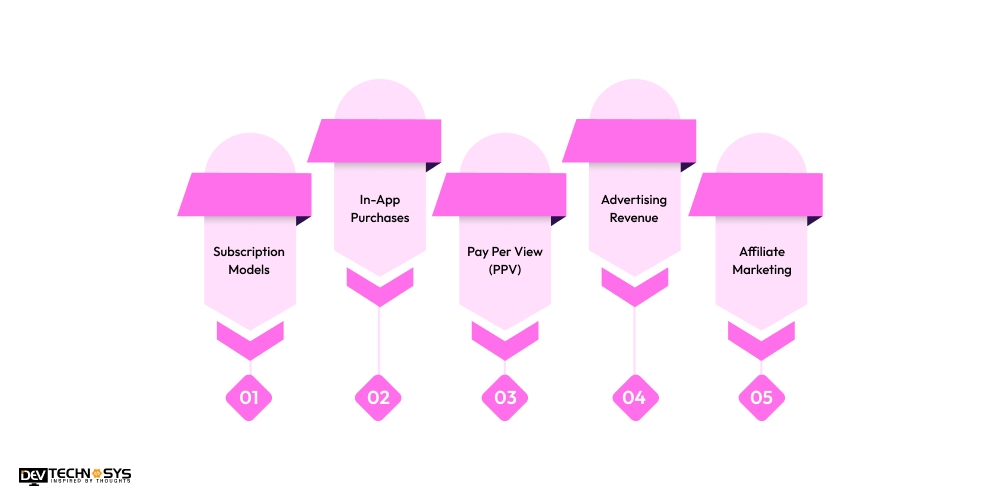
1. Subscription Models
Subscription-based monetization enables users to pay for access to premium content. This concept applies to both viewers and content developers. Viewers can subscribe to their favorite streamers or channels to get unique material, early access to streams, and ad-free experiences.
2. In-App Purchases
During live sessions, viewers can contribute money directly to streamers using virtual gifts and in-app purchases. These presents can be purchased with actual money and are frequently in the shape of animated emojis, badges, or virtual things. This strategy promotes audience participation while also providing content providers with a consistent money stream.
3. Pay Per View (PPV)
A Pay-Per-View approach can be especially beneficial for exclusive events such as concerts, live shows, and webinars. Users pay a one-time price to access premium material. According to the OTT app development company
4. Advertising Revenue
One of the most prevalent methods for monetizing a platform is to include adverts in live streaming. Ads might appear before, during, or after the stream. Video ads, banner ads, and interactive ads can all be included, with money split between app owners and content providers. Advertisers frequently pay based on views, clicks, and interaction.
5. Affiliate Marketing
Custom live video streaming solutions can use affiliate marketing by collaborating with brands and promoting products during live streams. Streamers can promote sponsored products or services to their audience while earning a percentage for each sale made via their unique affiliate links. As we discussed earlier with a mobile app development company, this enables the platform and creators to make money while promoting relevant products.
Conclusion
In 2025, live video streaming app development is a rapidly evolving field driven by advances in AI, 5G technology, and interactive features. To succeed, developers must focus on scalability, security, and user experience. The integration of real-time interaction, multi-device compatibility, and monetization options are key trends.
As the demand for immersive, high-quality streaming grows, staying ahead with innovative features and performance optimization will be essential for success in this competitive market.
Are you looking to make a live video streaming app? Then, connect with a video streaming app development company in UAE to receive innovative featured solutions.
Frequently Asked Questions
1. How Much Does It Cost To Develop a Live Video Streaming App?
The cost to build a live video streaming app ranges between $8,000 to $25,000+, depending on features, platform, complexity, and development team location, with ongoing costs for servers, maintenance, and updates.
2. How Much Time Does It Take To Create a Live Video Streaming App?
To create a live video streaming app, it basically takes 3 to 6 months, depending on the app’s complexity, features, platform choice, and team size, including time for testing, deployment, and bug fixes.
3. What Technologies are Used in Live Video Streaming App Development?
Interactive streaming apps use technologies like RTMP, HLS, and WebRTC for streaming, React/Angular for frontend, Node.js/Python for backend, AWS/Google Cloud for cloud services, and FFmpeg for video encoding/transcoding.
4. What Are the Top Trends in Live Video Streaming Apps in 2025?
Top trends in 2025 include 5G for low-latency streaming, AI-powered recommendations, VR/AR integration, live shopping, advanced monetization options, 4K/8K streaming, and enhanced content moderation with AI and automation.
5. What Are the Common Challenges in Developing a Live Streaming App?
Common challenges include ensuring low-latency streaming, handling high traffic, video quality optimization, scalability, server management, user security, copyright protection, and integrating monetization options like ads or subscriptions effectively.



